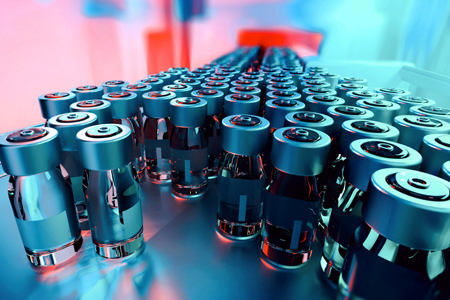Improving The Accuracy Of Automated Lyophilized Vial Inspection

Table of Contents
Understanding the Challenges in Lyophilized Vial Inspection
Visual inspection of lyophilized vials presents numerous difficulties, even for experienced inspectors. Human limitations significantly impact the accuracy and consistency of manual checks. Subtle defects often go undetected, leading to potential product recalls and regulatory issues. Key challenges include:
- Subtle cracks or imperfections: Microscopic cracks or fissures in the vial glass are easily missed by the naked eye, potentially compromising product sterility and integrity.
- Variations in cake appearance and formation: The appearance of the lyophilized cake (the dried drug substance) can vary subtly, and inconsistencies might indicate issues with the freeze-drying process. Manual inspection struggles to consistently identify these variations.
- Contamination detection: Identifying particulate matter or microbial contamination within the vial requires keen eyesight and careful examination – a process prone to human error and fatigue.
- Human error and fatigue: Manual inspection is time-consuming and monotonous. Inspector fatigue leads to reduced vigilance and increased error rates, impacting overall accuracy and consistency.
Examples of difficult-to-detect defects: hairline cracks, minute particulate matter, subtle variations in cake collapse, discoloration barely visible to the naked eye. These often require magnification and specialized lighting for detection, highlighting the limitations of manual methods.
Key Technologies Enhancing Automated Lyophilized Vial Inspection Accuracy
Modern automated lyophilized vial inspection systems leverage advanced technologies to overcome the shortcomings of manual inspection. These systems significantly enhance accuracy and speed, ensuring higher quality control and reduced human error. Key technological advancements include:
- High-resolution imaging: High-resolution cameras and sophisticated lighting techniques (e.g., structured illumination, coaxial lighting) provide detailed images of the vials, revealing subtle defects invisible to the naked eye.
- Advanced image processing algorithms: Sophisticated algorithms analyze the images, identifying deviations from pre-defined acceptance criteria. These algorithms are designed to minimize false positives and improve the sensitivity of defect detection.
- AI and machine learning: Artificial intelligence and machine learning algorithms learn from large datasets of inspected vials, continuously improving their ability to detect and classify defects. This adaptive learning capability enhances accuracy over time.
- Spectral analysis: Techniques like near-infrared (NIR) spectroscopy can analyze the chemical composition of the lyophilized cake and identify hidden defects or inconsistencies not detectable through visual inspection alone.
Examples of manufacturers and their advanced systems: Companies like [Insert example company names and their relevant technologies here] offer automated inspection systems incorporating these technologies. Researching these specific solutions can provide valuable insight into the capabilities of modern automated systems.
Optimizing Automated Lyophilized Vial Inspection Systems for Maximum Accuracy
Achieving maximum accuracy from automated lyophilized vial inspection systems requires a multi-faceted approach focusing on system optimization and robust quality control procedures. Key steps include:
- Proper system calibration and maintenance: Regular calibration using certified standards is crucial to maintain the accuracy and precision of the system. Preventative maintenance schedules should be followed meticulously to minimize downtime and ensure consistent performance.
- Effective data analysis and reporting: The system should generate comprehensive reports detailing inspection results, including defect types, frequencies, and locations. Statistical process control (SPC) charts and other data analysis tools can identify trends and areas for improvement.
- Defining clear acceptance criteria: Establishing clear and objective criteria for defect acceptance/rejection is essential for consistent and compliant inspection. These criteria should align with regulatory guidelines and internal quality standards.
- Implementing robust quality control measures: Regular performance verification tests, using known good and bad samples, ensure the system remains accurate and reliable. Operator training and quality assurance protocols are also critical.
- Regulatory compliance: Automated inspection systems must comply with relevant regulations, such as those outlined by the FDA and other regulatory bodies. Validation procedures and documentation are essential for demonstrating compliance.
Checklists: A regular maintenance checklist should detail tasks like camera cleaning, lighting adjustments, and software updates. Similarly, data analysis checklists can guide operators in reviewing reports, identifying trends, and implementing corrective actions.
The Role of Human Oversight in Automated Lyophilized Vial Inspection
While automation significantly improves accuracy and efficiency, human oversight remains crucial. Experienced personnel are needed to:
- Interpret complex results: In cases where the system flags ambiguous results, human expertise is needed for accurate classification.
- Manage exceptions: Automated systems may require manual intervention to address unusual situations or unexpected errors.
- Maintain system performance: Regular monitoring of the system's performance and prompt troubleshooting are essential for maintaining accuracy.
- Continuous improvement: Human oversight contributes to ongoing improvements in system parameters, algorithms, and processes.
Conclusion
Improving the accuracy of automated lyophilized vial inspection is essential for ensuring product quality and regulatory compliance. Manual inspection falls short in speed, accuracy, and consistency, leading to potential risks. Modern automated systems, leveraging advanced technologies like high-resolution imaging, AI, and spectral analysis, dramatically improve the inspection process. By implementing robust quality control measures, optimizing system parameters, and ensuring proper human oversight, pharmaceutical manufacturers can significantly enhance the accuracy and reliability of their automated lyophilized vial inspection processes. Invest in improving your automated lyophilized vial inspection today for enhanced product quality and regulatory compliance.

Featured Posts
-
 Selena Gomezs 3 000 Benny Blanco Ring A 12 Sale
May 12, 2025
Selena Gomezs 3 000 Benny Blanco Ring A 12 Sale
May 12, 2025 -
 Divorce D Eric Antoine Presentation De Sa Nouvelle Compagne Visage Familier De M6
May 12, 2025
Divorce D Eric Antoine Presentation De Sa Nouvelle Compagne Visage Familier De M6
May 12, 2025 -
 Kritiki Jay Kelly I Nea Tainia Me Toys Kloynei Kai Santler
May 12, 2025
Kritiki Jay Kelly I Nea Tainia Me Toys Kloynei Kai Santler
May 12, 2025 -
 Possible Candidates For The Next Pope A Conclave Preview
May 12, 2025
Possible Candidates For The Next Pope A Conclave Preview
May 12, 2025 -
 Covenant Health Park Opening Preceded By East Tennessee History Center Baseball Exhibit
May 12, 2025
Covenant Health Park Opening Preceded By East Tennessee History Center Baseball Exhibit
May 12, 2025
Latest Posts
-
 Stallones Favorite Rocky Unveiling The Franchises Most Poignant Chapter
May 12, 2025
Stallones Favorite Rocky Unveiling The Franchises Most Poignant Chapter
May 12, 2025 -
 Which Rocky Movie Touches Stallone The Most The Actor Names His Emotional Favorite
May 12, 2025
Which Rocky Movie Touches Stallone The Most The Actor Names His Emotional Favorite
May 12, 2025 -
 Rockys Emotional Heart Stallone Reveals His Favorite Film In The Iconic Franchise
May 12, 2025
Rockys Emotional Heart Stallone Reveals His Favorite Film In The Iconic Franchise
May 12, 2025 -
 The Forgotten Directing Effort Of Sylvester Stallone A Box Office Bomb
May 12, 2025
The Forgotten Directing Effort Of Sylvester Stallone A Box Office Bomb
May 12, 2025 -
 Sylvester Stallones Underrated Directing Career Focusing On His One Non Acting Film
May 12, 2025
Sylvester Stallones Underrated Directing Career Focusing On His One Non Acting Film
May 12, 2025
